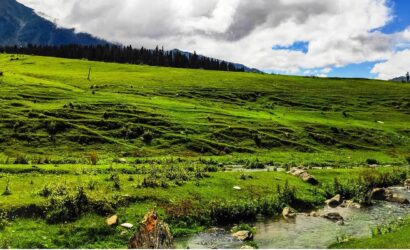Water Rafting
River rafting in Kashmir is one such activity that fills the itinerary with some slashing moments.
River rafting in Kashmir mostly combats against rapids ranging from Grade I to III but it also runs down through Grade IV rapids in some stretches.
Rafting in Kashmir
Kashmir’s two major natural advantages are its mountains on the one hand, and lakes and rivers on the other. These waterways enhance the beauty of the land and are one of the chief sources that attract tourists to its verdant valleys. But more than just a means of pleasure, the water-ways are an activity oriented way of discovering new lei-sure sports.
To those of you who are by nature passive, there is little more needed than a wining nod to a passing shikara-wala before you are invited on board these narrow boats with their sprung-cushion seats and chintz curtains. You can command a shikara on the Dal and Nagin lakes in Srinagar for just a crossing, or for a whole day, and dis-cover the tranquillity of being gently oared over water from one scenic spot to another. You can also stretch your time limit by actually staving aboard a houseboat so you wake to the sound of soft waves lapping beside your bedroom window.
A variation on this can be the hiring of a motor boat so you travel faster over water. Or better still, when the summer days are balmy, go water skiing. Interested en-thusiasts can use the facilities of the Watersports Institute at Nagin Lake.
The Jhelum river has remained the lifeline of Srinagar, and there are people who live on the river in boats, called doongas. These water-people claim to be descendants of Noah. If you hire a slow boat from them, you can actually visit old parts of Srinagar where, because of narrow, wind-ing roads, access by taxi is almost impossible. The advan-tage of going by boat is that you get to see numerous old mosques and temples, as well as attractive houses, that line the banks hut cannot be viewed or photographed from land. Constructed of wood, and with carved and latticed balconies and verandahs, they are well maintained and preserve the ancient heritage of Srinagar.
As you float past the houseboats moored along the river front, you also have the opportunity to observe the life of the people of Kashmir. In succession, the numerous bridges spanning the Jhelum pass by (and at places are ferry services for local travel). Srinagar city is located by the banks between Zero Bridge and Chattabal where a meir controls the water level on this stretch. A small lock on the west bank allows the movement of boats up or down stream. Once past Chattabal, the river changes character as it widens and meanders past visages in the valley. The river flows into the giant Wular Lake but the journey is best terminated at Manasbal Lake.
The advantage of cruising by a low powered boat over a shikara or a doonga is that a river-trip from Anantnag to Manasbal is considerably shortened over its three days, that photography is more convenient, and that mooring at the place of your choice is not restricted.

Delightful Kashmir
This is a Special Kashmir Tour which includes all the special tourist attraction of Srinagar city famous Mughal Gardens and...
